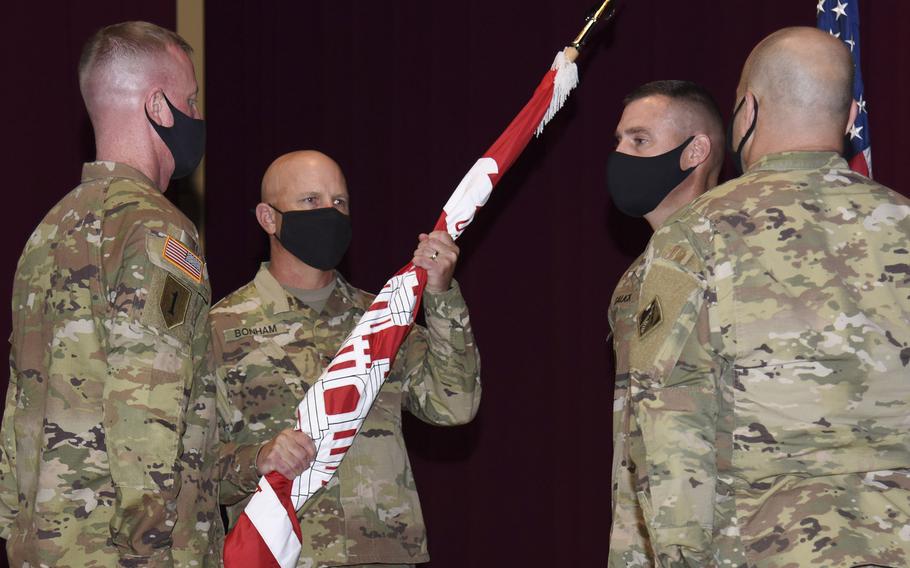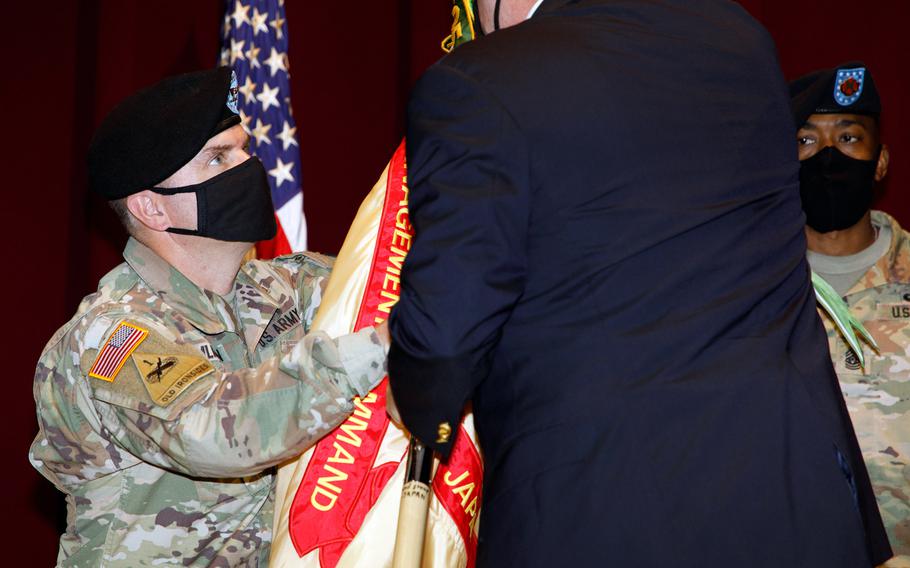
Col. Gary Bonham, holding the guidon, takes command of the Army Corps of Engineers, Japan Engineer District, from Col. Thomas Verell at Camp Zama, Japan, Tuesday, July 20, 2021. (Juan King/Stars and Stripes)
CAMP ZAMA, Japan – A pair of commands changed hands Tuesday at the headquarters of U.S. Army Japan, southeast of Tokyo, one for the garrison and the other for the Corps of Engineers.
Col. Thomas Matelski turned over control of U.S. Army Garrison Japan to Col. Christopher Tomlinson, a former enlisted soldier and company commander in Iraq. Meanwhile, command of the Army Corps of Engineers, Japan Engineer District, passed from Col. Thomas Verell to Col. Gary Bonham.
Matelski during the ceremony reflected on the challenge presented by the coronavirus pandemic, which consumed nearly half of his three-year tenure.
“Although my time in command has been one of the most difficult of my career, it has also been the most rewarding,” he said, according to an Army news release. “The country of Japan and the Japanese people have taught me so much. I’ve been all over the world in my Army career … but I’ve never found a culture and people that my family and I have enjoyed so much.”
A native of Racine, Wis., Matelski is moving to Indo-Pacific Command in Hawaii to become chief of the Civil Affairs Planning Team, J9.
His handling of the pandemic on installations in Japan drew praise from Craig Deatrick, director of Installation Management Command – Pacific, the reviewing officer at Tuesday’s ceremony.
Matelski “shepherded the community through the associated challenges, building a robust and effective communications strategy, helping keep soldiers, families and civilians safe and informed on the latest guidance and direction,” Deatrick said, according to the release. “Despite the challenges presented by the pandemic, Col. Matelski consistently improved relationships with senior leaders and foreign dignitaries here in Japan.”
U.S commanders of installations of all branches across Japan are responsible for preventing the spread of COVID-19, the coronavirus respiratory disease, into their populations.
The Army garrison commander has charge of the headquarters post and 15 other Army facilities throughout Japan, and the support they provide 12,000 service members, Defense Department employees, families and Japanese employees.

Col. Christopher Tomlinson accepts the U.S. Army Garrison Japan flag during a change-of-command ceremony at Camp Zama, Japan, Tuesday, July 20, 2021. The outgoing commander, Col. Thomas Matelski, is moving to Indo-Pacific Command in Hawaii to become chief of the Civil Affairs Planning Team, J9. (Kei Sasaki/U.S. Army)
Between March 2020 and May, U.S. Army Japan reported at least 99 coronavirus cases had surfaced on its posts.
Tomlinson, the new garrison commander, hails from Gruver, Texas. He served four years in the enlisted ranks, then graduated in 1996 with an ROTC commission from Texas Tech University. From there he rose up as an infantry, airborne and military intelligence officer and a Ranger, according to the Army.
His overseas service includes stints in Germany and Iraq. He previously commanded Fort Belvoir, Va., and comes to Japan from the Joint Staff J-2 Directorate at the Pentagon, where he served as deputy director of intelligence in the National Military Command Center.
At the Corps of Engineers ceremony, Bonham took charge of the largest district in the Pacific.
A native of Reno, Nev., Bonham graduated in 1994 with a ROTC commission and a bachelor’s in civil engineering from the University of Nevada, Reno, and has held posts in Germany, Hawaii, California and New Mexico.
He comes to Japan from the Defense Threat Reduction Agency, where he was deputy of the Enabling Capabilities Department, Research & Development Directorate. He has also served as director of the agency’s National Assessment Group.
The engineer district has a workforce of about 460 people, including U.S. and Japanese civilians, and provides peacetime and contingency engineering and construction services for the U.S. military, according to the district’s website. It manages the Corps of Engineer’s largest design and construction program funded by a host nation.
One of its projects is a new 9,100 square-foot flight simulator for the CV-22 Osprey being built on Yokota Air Base, home of U.S. Forces Japan in nearby western Tokyo.
The structure, scheduled to open in September 2023, will support the only full-motion Osprey simulator in the region, according to the Japan Engineer District. The Osprey is a tilt-rotor aircraft with both vertical and short take off capabilities.
The Air Force in December 2019 began construction on $63 million worth of facilities at Yokota for the 21st Special Operations Squadron, which flies the tiltrotors there.
Stars and Stripes reporter Joseph Ditzler contributed to this report.